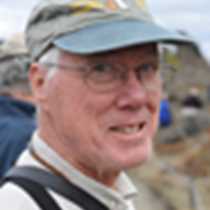Neko Harbour and Port Lockroy, Antarctica
There are many things that we expect to see on our voyage, and we are enthralled when we do. On this list I count albatross soaring over the swells of the Southern Ocean, penguins stealing stones from their neighbors' nests, seals on floating platforms of ice, snow-covered landscapes, and giant icebergs in shades of white, blue, and green. And then there are the unexpected moments, the things that we had only dared hope. High on this list are Antarctic killer whales. Killer whales occur in all of the world's oceans, but as top carnivores, they are nowhere common. After dinner last night, near the northern entrance to the Neumeyer Channel, we found them. Boy, did we find them! Our Expedition Leader made three announcements in sequence: "You might want to come out on deck"; "You do want to come out on deck"; "Get the heck out on deck, because this is exceptional." We did, and it was.
Killer whales (you can call them orca if you wish) are among the most social of marine animals. They live in kin-structured pods; that is, they travel with their close relatives, and they capture and consume their prey cooperatively. It works well until the time comes to mate and you find yourself surrounded by your mother and sisters. Occasionally two or more pods join to form a "superpod"; that is when mating occurs with members of other pods, thus avoiding inbreeding. Last night we encountered a superpod. There was a minimum count of twenty-six whales seen at a single moment, and probably a good deal more. Fins were all around us: the tall, erect triangular fins of adult males and the shorter curved fins of females and immature males. When they surfaced near the ship, as they did repeatedly, we could see that these were not the classic jet-black and white killer whales. Instead, their backs were in two tones of gray, and often discolored by a yellow-brown smear of diatoms. The eye patch, the white area behind the eye, was very large and elongate. Whale biologists now recognize that what we once called "the killer whale" is actually a complex of distinct forms that differ in appearance, vocal dialect, and preferred prey. The whales recognize the differences and breed only within their type, so they must be considered distinct species. We believe these whales to be of a type (Type-B) that is regularly found around the Gerlache Strait (our present location), and specializing in penguins as food. Much more research is needed. We are happy to say that two prominent whale biologist will be aboard our ship in January, using National Geographic Explorer as a research platform and sharing the results of their research with the scientific community and with guests aboard. Stay tuned.
This morning we landed at Neko Harbour to set foot on the Antarctic Continent, a memorable moment for many of us. We celebrated the moment by climbing to a scenic overlook, shedding jackets, hats, and gloves in the warm Antarctic sun. (Did I really just write that? But it is true.) Weddell seals were lying inertly on the snow seeming to enjoy the sun without the need to climb high.
Following lunch, we visited the former British base at Port Lockroy. It operated as a research base from 1944 to 1962. Following restoration by the U.K. Antarctic Heritage Trust, it operates as an Antarctic museum and gift shop (the proceeds supporting the restoration of historic Antarctic huts.) Some of us seized the opportunity to paddle kayaks around the harbor of Port Lockroy, which fact our friends and family still might not believe. It wasn't warm anymore; in fact, snow was flying in the Antarctic wind, but that only adds to our stories.




